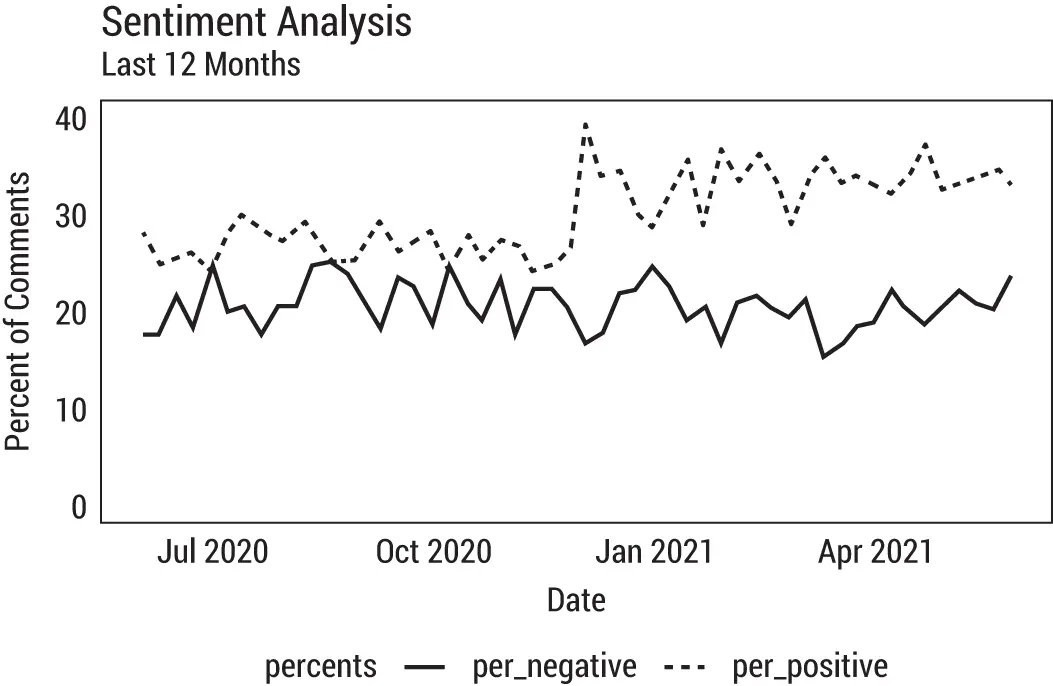At the kick-off meeting, the project sponsor and data scientist quickly and excitedly discuss something called “sentiment analysis.” The project sponsor heard about it at a recent tech conference after a competing company reported using it. The data scientist volunteered they knew sentiment analysis, having implemented it in their senior capstone project. They think it might be a good technique to apply to customer comments on the company's Twitter and Facebook pages. The marketers understand the technique as being able to interpret people's emotional reactions using social media data, but they don't say much.
The basic premise, you are told, is that sentiment analysis can automatically label a tweet or Facebook post as “positive” or “negative.” For instance, the phrase, “Thank you for sponsoring the Olympics.” is positive , whereas “Horrible customer service” is negative . Conceivably, the data scientist could count the daily totals of positives and negatives, plot the trends over time (and in real time!), and subsequently share the results via a dashboard for all to see. Most important: no one needs to read customer comments anymore. The machine will do it for everyone. So, it's decided. The project kicks off.
A month later, the data scientist proudly shows off Company X's Customer Perception Dashboard. It's updated each day to include the latest data and lists some of the week's “positive” comments along the side. Figure 1.1zooms in on the main graphic in the dashboard: trendlines of sentiment over time. Only positive and negative values are shown, and most comments are neutral.
The project sponsor loves it. A week later, the dashboard is displayed on a monitor in the break room for all to see.
Success.
Six months later, the break room is renovated, and the monitor is removed.
No one notices.

FIGURE 1.1Sentiment analysis trends
A postmortem of the project revealed no one in the company used the analysis, not even the marketers on the team. When asked why, the marketers admit they weren't really comfortable with the original analysis. Yes, it was possible to label each communication as positive or negative. But the idea that nobody would need to read comments anymore seemed like wishful thinking. They questioned the degree to which the labeling process had even been useful. Further, they countered that perception couldn't only be measured by online interaction even if that was the dataset most readily available to support sentiment analysis.
In this scenario, it seemed like everything went well. But the fundamental question— why is the project important? —doesn't appear to have been brought up. Instead, the project team moved forward attempting to answer another question: “Can we build a dashboard to monitor the sentiment of customer feedback on the company's Twitter and Facebook pages?” The answer, of course, was yes, they could. But in the end the project wasn't useful or even important to the organization.
You would think marketers would have had more to say, but they were not identified as people who would have been affected by the project. In addition, this project exhibited two early warning signs in how the team attempted to solve the problem: methodology focus (sentiment analysis) and deliverable focus (dashboard).
Moreover, the project team in the Customer Perception scenario could have taken their problem, “Can we build a dashboard to monitor the sentiment of customer feedback on the company's Twitter and Facebook pages?” and performed a solution trial run. They could have assumed a dashboard was available and updated daily with positive/negative sentiments of social media comments:
Can we use the answer? The team would be thinking about the relevance of sentiment analysis on customer perception. How can the team use the information? What is the possible business benefit of knowing the sentiment of customers on social media?
Whose work will change? Suppose the team convinces itself that knowing sentiment is important in order to be good stewards of the business. But is someone going to monitor this dashboard? If the trends suddenly go down, do we do anything? What if they trend up?
At this point, the marketing team would have hopefully spoken up. Would they have known what to do differently in their daily work with that kind of information? Likely not. The project, in its current form, hit a wall.
If only they asked the five questions.
WORKING ON PROBLEMS THAT MATTER
So far, we've tied project failures to not defining the underlying problem correctly. Mostly, we've placed this failure in terms of losing money, time, and energy. But there's a broader issue happening all over the data space, and it's something that you wouldn't expect.
Right now, the industry is focused on training as many data workers as possible to meet the demand. That means universities, online programs, and the like are churning out critical thinkers at lightning speed. And if working in data is all about uncovering the truth, then Data Heads want to do just that.
What does it mean, then, when they sit down to a project that doesn't whet their appetite? What does it mean for them to have to work on a poorly defined issue where their skills become bragging rights for executives but don't actually solve meaningful problems?
It means many data workers are dissatisfied at their jobs. Having them work on problems overly focused on technology with ambiguous outcomes leads to frustration and disillusionment. Kaggle.com, where data scientists from all over the world compete in data science competitions and learn new analysis methods, posted a survey and asked data scientists what barriers they face at work. 2 Several of the barriers, listed here, are directly related to poorly defined problems and improper planning:
Lack of clear question to answer (30.4% of respondents experienced this)
Results not used by decision makers (24.3%)
Lack of domain expert input (19.6%)
Expectations of project impact (15.8%)
Integrating findings into decisions (13.6%)
This has obvious consequences. Those who aren't satisfied in their roles leave.
The very premise and structure of this book is to teach you to ask more probing questions. It starts with the most important, and sometimes hardest, question: “What's the problem?”
In this chapter, you learned ways to refine and clarify the central business question and why problems involving data and analysis are particularly challenging. We shared five important questions a Data Head should ask when defining a problem. You also learned about early warning signs to spot when a question starts to go off track. If the question hints of having a (1) methodology focus or a (2) deliverable focus, it's time to hit pause.
When these questions are answered, you are ready to get to work.
1 1 A robust data strategy can help companies mitigate these issues. Of course, an important component of any data strategy is to solve meaningful problems, and that's our focus in this chapter. If you'd like to learn more about high-level data strategy, see Jagare, U. (2019). Data science strategy for dummies. John Wiley & Sons.
2 2 2017 Kaggle Machine Learning & Data Science Survey. Data is available at www.kaggle.com/kaggle/kaggle-survey-2017. Accessed on January 12, 2021.
“If we have data, let's look at data. If all we have are opinions, let's go with mine.”
Читать дальше













